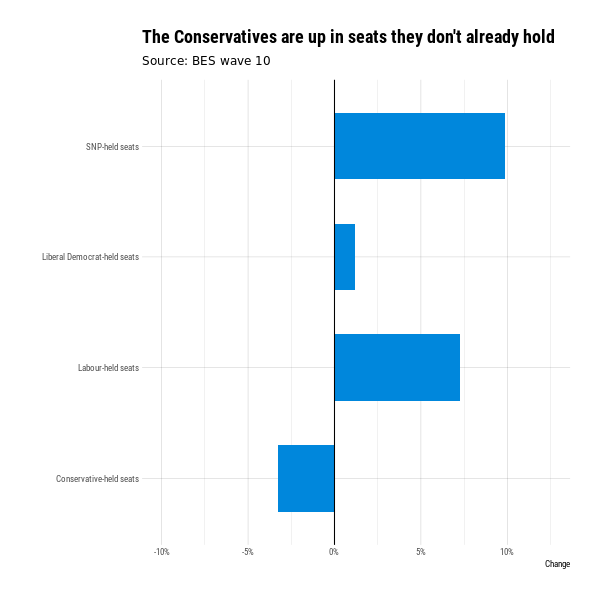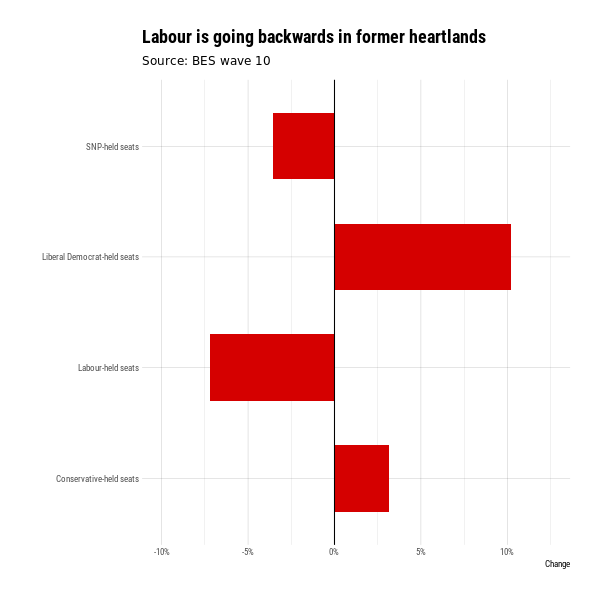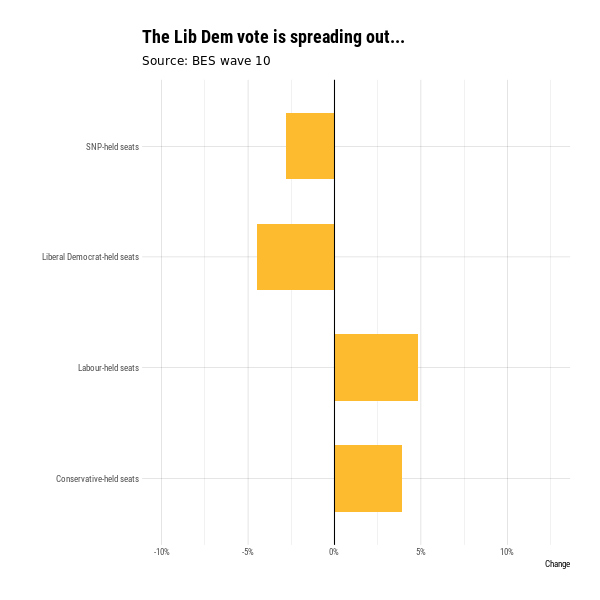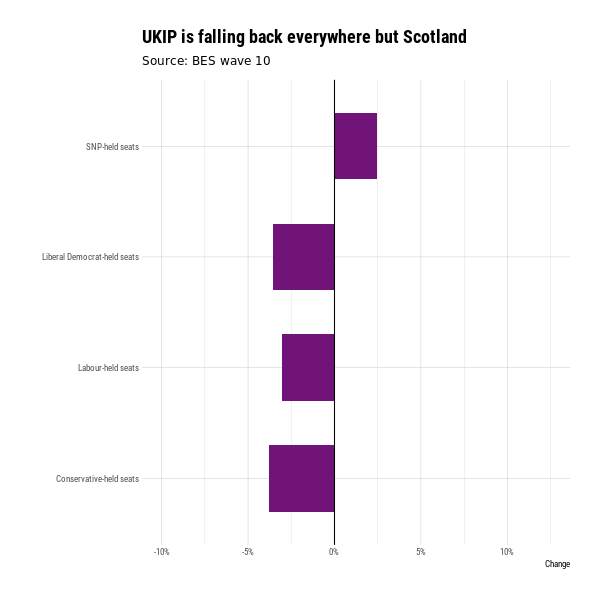Chris Hanretty notes that there are some warning signs for Labour as data suggests Conservatives are piling up votes in Labour-held seats.
On Friday, the British Election Study team released data from the tenth wave of their study, conducted in December of last year.
This release, like those that preceded it, is important because it allows researchers to investigate vote intention not just amongst the general population (that you can get from the headline figures in published opinion polls), but also amongst other arbitrary groupings.
The BES team has already published an analysis of two important groups — or rather, two sets of groups: Leave and Remain voters according to their past and current vote intention. Because the BES surveys several thousand people in each wave, these subgroups can be meaningfully analysed.
My interest is in how people vote depending on the type of seat they live in. In particular, I’m interested in where the “new” Conservative voters are.
Since the general election, the Conservatives’ opinion poll ratings have risen consistently. In the general election, they won 37% of the vote. One poll last night from ComRes put the Conservatives on 50%, an increase of thirteen percentage points.
If the Conservatives increase their share of the vote by thirteen percentage points everywhere — which is what uniform national swing would suggest — then they win an awful lot of seats. But what if they increased their vote share more in some seats rather than others — how might that matter for their seat haul?
I decided to calculate the share of the vote going to each party in Conservative-, Labour- and Liberal Democrat-held seats (“current shares”). I weighted these shares according to the weights given to each respondent in wave 9 of the BES survey. (Wave 10 weights are not yet available).
When weighted in this way, the Conservatives are on 39% of the vote, and Labour on 31% — lower than current polls, but not too different from polling when Wave 10 was fielded late last year. The estimates of “current” shares may therefore represent an under-estimate of Conservative strength in these seats, and an over-estimate of Labour strength.
I could show you these current shares across different types of seats — but for my purposes it’s easier to show you the changes: the difference between current shares and the known results from GE2015.
The first graph shows the change in the Conservative vote share in SNP-held, Labour-held, Liberal Democrat-held, and Conservative-held seats.

Although the Conservatives would prefer to limit losses in existing seats, these kinds of changes are very favourable for the Conservatives’ overall seat total. An increase of seven percentage points in Labour-held seats would, coupled with a fall in the Labour vote in those seats, represent a major incursion into Labour territory.
For Labour, the picture is not good. They are falling backwards in seats that they already hold. It’s true that they are up relative to the election in Conservative seats, but this averages over a large number of individual constituency results, including constituencies in which Labour has no chance of winning.

The combined effect of these changes would be to put Labour-held seats with majorities of 14% at risk to a fall in the Labour vote share of (roughly) seven percentage points, combined with an increase in the Conservative vote share of (roughly) seven percentage points.
Conversely, some Conservative-held seats would be put at risk, but these would be at risk from a combination of a much smaller increase in the Labour vote share of three percentage points, and a decrease in the Conservative vote share of three percentage points.
We can complete the picture by showing changes in the Liberal Democrat and UKIP vote shares:

The picture for the Lib Dems meets a certain narrative of the Lib Dems fighting on two fronts — but falling back in seats that they currently hold could be disastrous for the party.

UKIP is falling back everywhere, except in Scotland, where it has no chance of winning a seat.
These figures represent the state of play in December of last year, using weights from even earlier. As I have already said, wave 10 of the BES, when weighted using the weights from the previous wave, under-estimates the increase in the Conservative vote share seen in current opinion polls. If all these swings are increased (or decreased) to bring them in line with current polling, the results could be truly disastrous for Labour. They would end up with fewer seats than would be predicted using a uniform national swing, because they would have fallen back in areas where the Conservatives are on the attack. Note though that the picture is complicated, and it’s possible that Labour might gain some Conservative seats even as it loses many more of its own.
Why might this pattern of changes occur? As Rob Ford has noted in today’s Observer, patterns of vote switching are crucial.
Apparently safe Labour seats could be jeopardised if Labour simultaneously leaks Remain votes to the Liberal Democrats and Leave votes to Ukip, while the Conservatives squeeze a large 2015 Ukip vote
The analysis above is more consistent with the second part of this analysis (“UKIP squeeze”) than the first part. A fuller analysis would have to bring in much more individual level data, maybe even some small area estimation. There are, however, clear warning signs for Labour that the party may under-perform in seats its current miserable levels in (reported) vote share.
Notes: You can find the code for this analysis at GitHub
Postscript: As a number of people have commented, the sample sizes for Lib-Dem held seats are much smaller than the sample sizes for other seats (c. 200 versus five or six thousand). The figures for those seats should therefore be treated with caution.
Post-postscript: Readers of this post may also be interested in ICM’s new cross-breaks, which show vote intention by seat marginality.
Image credit: By Diliff – Own work, CC BY-SA 2.5,





